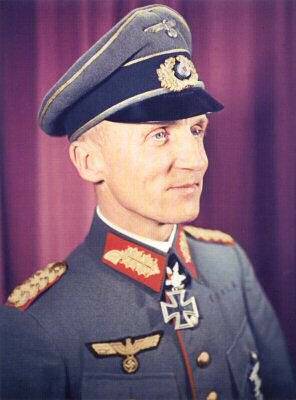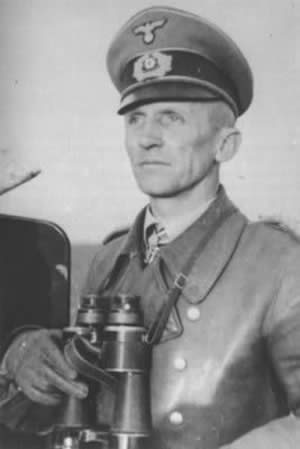Manteuffel, von, Hasso Eccard
- Date of birth:
- January 14th, 1897 (Potsdam/Brandenburg, Germany)
- Date of death:
- September 24th, 1978 (Reith im Alpbachtal/Tyrol, Austria)
- Nationality:
- German
Biography
Hasso von Manteuffel was born 14 January 1897 in Potsdam near Berlin, Germany to an aristocratic Prussian family. Already at a young age, he opted for an army career. After having graduated from cadet school, he joined a regiment of Hussars in 1908.
During WW 1 he distinguished himself at the Western Front and was awarded the Iron Cross First and Second Class. After the war he remained in the Reichswehr, which was restricted to 100,000
men by the Versailles Treaty. After Hitler took power he was named commander of a motorized infantry battalion. He subsequently became a lecturer at various military schools, familiarizing recruits with armored weaponry. He was also involved in motorizing the new Wehrmacht. Until the launch of Operation Barbarossa, Manteuffel was not actively engaged in military operations.
Just before Germany invaded the Soviet Union, Manteuffel was given command of a mechanized infantry battalion of 7.Panzer-Division. After the start of Operation Barbarossa, 7. Panzer-Division advanced far into Russia and was involved in the battles for Smolensk and Vjazma. In recognition of his performance at the front, Manteuffel was promoted to Colonel. At the onset of winter, the drive on Moscow was resumed and Manteuffel's regiment captured a key bridge on the Moscow-Volga Canal. Following this action,
Manteuffel was awarded the Knight's Cross. Manteuffel managed to advance another 50 kilometers. During the winter offensive, they were forced to retreat but 7. Panzer-Division succeeded in preventing a breakthrough. From July 1942 onwards, Manteuffel commanded a motorized infantry brigade of 7. Panzer-Division.
In the winter of 1942, Manteuffel was transferred, quite unexpectedly to Tunisia in North Africa and was very successful as commander of a motorized infantry division. Manteuffel was not present when the German Afrika Korps surrendered. He had fallen ill and had returned to Germany for recuperation so he could continue taking an active part in the war.
Afterwards he returned to the Eastern Front. He was held in high regard by his men. At Zjitomir in the Ukraine, he inflicted severe losses on the Soviets by astute maneuvering.
On 1 September 1944, he was transferred to the Western Front, following his promotion to General der Panzer and was given command of 5.Panzer-Armee.
During the Ardennes Offensive, he was to form the left flank next to 6.SS- Panzer-Armee. Manteuffel and his men barely reached their goal but were ultimately driven back. After the failure of the offensive, Manteuffel was again transferred to the Eastern Front. There he came under the command of Generaloberst Heinrici who commanded Heeresgruppe (Army Group) Weichsel. The army group was tasked to halt the Soviet drive on Berlin. Heinrici thought the idea futile and refused to follow orders from the Army High Command. Subsequently, Manteuffel was asked to take command of the army group but he refused. To prevent himself and his men from falling into Soviet hands, he ordered a massive retreat towards the Elbe River where he surrendered 300,000 men to the British.
In 1948, he was released from prison. After his release, he was actively engaged in German politics. He was a member of the Bundestag (German parliament) from 1953 to 1957 representing the FDP (Freie Demokratische Partei, Liberal Party). In 1959, he was suddenly charged with a war crime. He had brought a deserter to a military tribunal and had him shot. Although this did not contravene any laws of war, he was sentenced to 2 years imprisonment nonetheless. With the help of Bundespräsident (President) Heuss, he was released four months later.
Hasso von Manteuffel died 24 September 1978 during a trip through Austria at the age of 81.
Promoytions:
February 22nd, 1916: Fähnrich;
April 28th, 1916: Leutnant (Patent January 28th, 1915);
April 1st, 1925: Oberleutnant;
April 1st, 1934: Rittmeister;
October 1st, 1936: Major;
April 1st, 1939: Oberstleutnant;
October 1st, 1941: Oberst;
May 1st, 1943: Generalmajor;
February 1st, 1944: Generalleutnant;
September 1st, 1944: General der Panzertruppen (RDA January 1st, 1944).
Career:
February 22nd, 1916: Husaren-Regiment „von Zieten" (Brandenburgisches) Nr. 3, Rathenow;
January 1919: Adjutant, Freikorps von Burghard von Oven, Berlin;
May 1919: Reichswehr-Kavallerie-Regiment 18;
?: 2. Eskadron / 3. (Preußischen) Reiter-Regiment;
1924: Adjutant;
1936: Taktiklehrer, Panzertruppenschule I, Wünsdorf;
May 1st, 1941: Kommandeur, I. Bataillon, Schützen-Regiment 7;
August 25th, 1941: Kommandeur, Schützen-Regiment 6;
1941: Führer Kampfgruppe Manteuffel;
July 15th, 1942 - November 1942: Kommandeur, 7. Panzergrenadier-Brigade;
February 5th, 1943 - March 31st, 1943: Kommandeur Division „von Manteuffel";
August 22nd, 1943 - January 20th, 1944: Kommandeur, 7. Panzer-Division;
February 1st, 1944 - September 1st, 1944: Kommandeur, Panzergrenadier-Division "Großdeutschland";
September 10th, 1944: mit den Führung beauftragd, 5. Panzerarmee;
January 30th, 1945 - March 9th, 1945: Oberbefehlshaber, 5. Panzerarmee;
March 10th, 1945: Oberbefehlshaber, 3. Panzerarmee;
May 3rd, 1945 - December 1946: POW;
1953 - 1957: Mitglied Bundestag.
Do you have more information about this person? Inform us!
- Period:
- Second World War (1939-1945)
- Awarded on:
- 1939
- Period:
- Second World War (1939-1945)
- Awarded on:
- December 20th, 1940
- Period:
- Second World War (1939-1945)
- Rank:
- Oberstleutnant (Lieutenant-colonel)
- Unit:
- Kommandeur, I. Bataillon, Schützen-Regiment 7, 7. Panzer-Division, Heer
- Awarded on:
- July 22nd, 1941
Had already received the Iron Cross 2nd Class on October 13th, 1916.
- Period:
- Second World War (1939-1945)
- Rank:
- Oberstleutnant (Lieutenant-colonel)
- Unit:
- Kommandeur, I. Bataillon, Schützen-Regiment 7, 7. Panzer-Division, Heer
- Awarded on:
- August 1st, 1941
Had already received the Iron Cross 1st Class on May 2nd, 1917.
- Period:
- Second World War (1939-1945)
- Rank:
- Oberst (Colonel)
- Unit:
- Kommandeur, Schützen-Regiment 6, 7. Panzer-Division, Heer
- Awarded on:
- December 31st, 1941
- Period:
- Second World War (1939-1945)
- Awarded on:
- 1943
- Period:
- Second World War (1939-1945)
- Rank:
- Generalmajor (Brigadier)
- Unit:
- Kommandeur, 7. Panzer-Division, Heer
- Awarded on:
- October 8th, 1943
- Period:
- Second World War (1939-1945)
- Rank:
- Generalmajor (Brigadier)
- Unit:
- Kommandeur, 7. Panzer-Division, Heer
- Awarded on:
- November 16th, 1943
- Period:
- Second World War (1939-1945)
- Rank:
- Generalmajor (Brigadier)
- Unit:
- Kommandeur, 7. Panzer-Division, Heer
- Awarded on:
- November 23rd, 1943
332th Award.
- Period:
- Second World War (1939-1945)
- Rank:
- Generalmajor (Brigadier)
- Unit:
- Kommandeur, 7. Panzer-Division, Heer
- Awarded on:
- February 22nd, 1944
Three days later the village of Malin was stormed. In this attack Manteuffel personally led the attack spearhead of 6 Panzers and a Kompanie of the divisional Panzer-Aufklärungs-Abteilung against the Soviet defense that was spread out on three sides. Despite the hostile resistance Manteuffel’s soldiers reached the centre of the village, threw strong Soviet infantry forces back and smashed the Soviet armoured group south of the village (destroying 25 tanks in the process).
50th Award.
- Period:
- Second World War (1939-1945)
- Rank:
- Generalleutnant (Major-general)
- Unit:
- Kommandeur, Panzer-Division "Großdeutschland", Heer
- Awarded on:
- March 14th, 1944
- Period:
- Second World War (1939-1945)
- Rank:
- Generalleutnant (Major-general)
- Unit:
- Kommandeur, Panzer-Division "Großdeutschland", Heer
- Awarded on:
- May 8th, 1944
- Period:
- Second World War (1939-1945)
- Rank:
- Generalleutnant (Major-general)
- Unit:
- Kommandeur, Panzer-Division "Großdeutschland", Heer
- Awarded on:
- May 30th, 1944
- Period:
- Second World War (1939-1945)
- Rank:
- General der Panzertruppen (Lieutenant-General of Armoured Forces)
- Unit:
- Oberbefehlshaber, 5. Panzerarmee, Heer
- Awarded on:
- February 18th, 1945
24th Award.
- Period:
- Second World War (1939-1945)
- Period:
- Second World War (1939-1945)
- Period:
- Second World War (1939-1945)
- Period:
- Second World War (1939-1945)
- Period:
- Second World War (1939-1945)
- Period:
- Second World War (1939-1945)
- Period:
- Second World War (1939-1945)
Sources
- Photo 1: Wilco Vermeer
- Photo: Wilco Vermeer, The Netherlands
- - BARNETT, C., Hitler's Generals, Grove Press, New York, 1989.
- FEDERL, CH., Die Ritterkreuzträger der Deutschen Panzerdivisionen 1939-1945, VDM Heinz Nickel, Zweibrücken, 2000.
- FELLGIEBEL, W.P., Elite of theThird Reich, Helion & Company Limited, Solihull, 2003.
- KURSIETIS, A.J., The Wehrmacht at War 1939-1945, Uitgeverij Aspekt, Soesterberg, 1999.
- MANTEUFFEL, H. VON, Die 7. Panzer-Division, Podzun-Pallas-Verlag GmbH, Wölfersheim-Berstadt, 1978.
- THOMAS, FRANZ & WEGMANN, GüNTER, Die Eichenlaubträger 1940-1945, Biblio-Verlag, 1998.
- WILLIAMSON, G., Knight's Cross With Diamonds Recipients: 1941-45, Osprey Pub Co., 2006.
- Helden der Wehrmacht, Sammelband (Miscellany), FZ-Verlag GmbH, München, Deutschland, 2000
- Voorlopige verleningsoorkonde Eichenlaub via Hermann Historica 53.Auktion catalogue
- Soldbuch in Hermann Historica 55.Auktion catalogue
- Axis Biographical Research
- Island Farm - Prisoner of War Camp






















